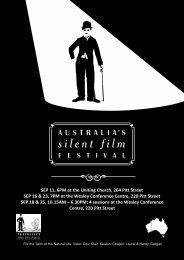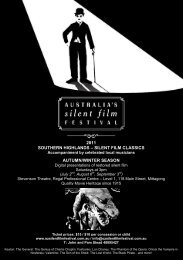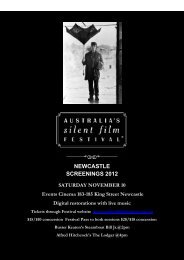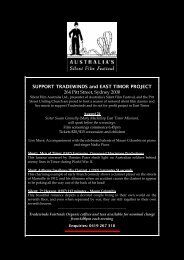NEWCASTLE SCREENINGS 2012 N - Australia's Silent Film Festival
NEWCASTLE SCREENINGS 2012 N - Australia's Silent Film Festival
NEWCASTLE SCREENINGS 2012 N - Australia's Silent Film Festival
You also want an ePaper? Increase the reach of your titles
YUMPU automatically turns print PDFs into web optimized ePapers that Google loves.
The Lodger - A story of the London Fog (1927) Great Britain 99 minutes<br />
Saturday November 10 @4pm<br />
Directed by Alfred Hitchcock, Novel written by Marie Belloc Lowndes.<br />
Cast : Ivor Novello, Marie Ault, Arthur Chesney, June Tripp, Malcolm Keen, Alfred Hitchcock and Alma Reville.<br />
The <strong>Festival</strong> acknowledges the generous assistance Park Circus Ltd.<br />
Highly acclaimed as Alfred Hitchcock’s best and most popular silent film, The Lodger is also an outstanding example of the visually<br />
artistic heights cinema had reached in the year 1927. In fact, the entire decade of the 1920s experienced rapid artistic and dramatic<br />
development, just as the previous two decades of motion pictures were revolutionary and ground-breaking.<br />
When editing, narrative and dialogue using title cards or intertitles had been mastered by the end of the 1910s, filmmakers began turning<br />
to the world of art and culture around them for new ideas and inspiration. Two of the most influential styles successfully expressed in<br />
early cinema were German Expressionism and Soviet Avant Garde.<br />
Alfred Hitchcock acknowledged that he was greatly inspired by German Expressionist directors F.W. Murnau and Fritz Lang when he<br />
worked at the famous old Babelsberg Studio in Berlin in the mid-1920s where he became well acquainted with the techniques and ideas<br />
behind Expressionism. In film, this art genre inspired the use of stark light and shadow to create mood and atmosphere, unusual camera<br />
angles and motion, and highly stylized and expressive acting, all in varying degrees.<br />
Hitchcock took the best of these techniques and blended them with his own style and ideas to create The Lodger, which is now regarded<br />
as his first true Hitchcockian film, although his lesser-known earlier film, Blackmail (1926), also clearly reveals all the famous hallmarks of<br />
the classic Hitchcock mystery thriller.<br />
The Lodger was adapted for the screen from the 1913 novel of the same name by Marie Belloc Lowndes, who based this ‘story of the<br />
London Fog’ on the Jack the Ripper murders. Such a subject is ideally suited to the Expressionist style, but Hitchcock uses these<br />
techniques sparingly and subtly, while adding other poignant qualities.<br />
5









